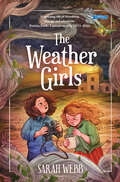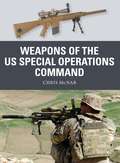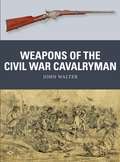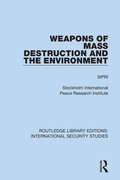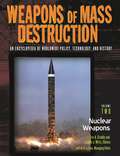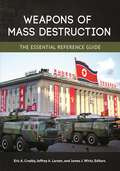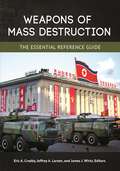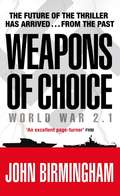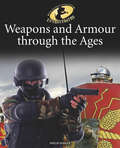- Table View
- List View
The Webley Service Revolver (Weapon)
by Peter Dennis Robert MazeThe Webley .455in service revolver is among the most powerful top-break revolvers ever produced. First adopted in 1887, in various marques it was the standard-issue service pistol for British and Commonwealth armed forces for nearly fifty years; later versions in .38in calibre went on to see further service in World War II and beyond, as well as in a host of law-enforcement roles around the world into the 1970s. Developed to give British service personnel the ability to incapacitate their opponents in 'small wars' around the globe, the Webley used the formidable – and controversial – .455in cartridge, a variant of which was known as the 'manstopper'. Users found it offered good penetration and excellent stopping power with only mild recoil – indeed, it was rated superior to the US .45 Colt in stopping power. Featuring specially commissioned full-colour artwork and close-up photographs, this is the compelling story of the Webley revolver, the powerful pistol that saw service across the British Empire and throughout two world wars.
The Webley Service Revolver (Weapon #19)
by Peter Dennis Robert MazeThe Webley .455in service revolver is among the most powerful top-break revolvers ever produced. First adopted in 1887, in various marques it was the standard-issue service pistol for British and Commonwealth armed forces for nearly fifty years; later versions in .38in calibre went on to see further service in World War II and beyond, as well as in a host of law-enforcement roles around the world into the 1970s. Developed to give British service personnel the ability to incapacitate their opponents in 'small wars' around the globe, the Webley used the formidable – and controversial – .455in cartridge, a variant of which was known as the 'manstopper'. Users found it offered good penetration and excellent stopping power with only mild recoil – indeed, it was rated superior to the US .45 Colt in stopping power. Featuring specially commissioned full-colour artwork and close-up photographs, this is the compelling story of the Webley revolver, the powerful pistol that saw service across the British Empire and throughout two world wars.
The Weather Girls
by Sarah WebbIt's 1944. Twelve-year-old Grace Devine lives at Blacksod Lighthouse and weather station in County Mayo with her parents and little brother. When a German plane crashes nearby, she and her best friend Sibby risk their lives to save the young pilot. Grace's family take him in, but their neighbours are horrified at having an 'enemy' in their midst. Meanwhile, the Met Office in England suddenly asks Blacksod to send them weather reports every hour. But why? As the wind and rain howl outside, Grace begins to understand that something important is happening, something to do with the war – and she is right in the eye of the storm. A tale of bravery, adventure and a remarkable friendship, inspired by true events from World War 2.
The Weather Factor: How Nature Has Changed History
by Erik DurschmiedThroughout history, natural elements have been responsible for the deaths of more people than the spear, bullet or atomic bomb. Floods have drowned millions, droughts and famines wiped out entire populations, frost has halted invincible armies, and storms have sunk unsinkable fleets.When facing the weather, its unpredictability can lead to incredible disasters. Though we have made major advancements in collecting and forecasting the weather, huge seas, skies, rain-falls and freezes have confounded us since the days when Noah was forced to take to the Ark.Erik Durschmied uses his formidable knowledge of military strategy and his skill at human observation to give examples of how man can never prepare for the unexpected.
Weary Warriors: Power, Knowledge, and the Invisible Wounds of Soldiers
by Pamela Moss Michael J. PrinceAs seen in military documents, medical journals, novels, films, television shows, and memoirs, soldiers’ invisible wounds are not innate cracks in individual psyches that break under the stress of war. Instead, the generation of weary warriors is caught up in wider social and political networks and institutions—families, activist groups, government bureaucracies, welfare state programs—mediated through a military hierarchy, psychiatry rooted in mind-body sciences, and various cultural constructs of masculinity. This book offers a history of military psychiatry from the American Civil War to the latest Afghanistan conflict. The authors trace the effects of power and knowledge in relation to the emotional and psychological trauma that shapes soldiers’ bodies, minds, and souls, developing an extensive account of the emergence, diagnosis, and treatment of soldiers’ invisible wounds.
Weary Warriors: Power, Knowledge, and the Invisible Wounds of Soldiers
by Michael J. Prince Pamela MossAs seen in military documents, medical journals, novels, films, television shows, and memoirs, soldiers’ invisible wounds are not innate cracks in individual psyches that break under the stress of war. Instead, the generation of weary warriors is caught up in wider social and political networks and institutions—families, activist groups, government bureaucracies, welfare state programs—mediated through a military hierarchy, psychiatry rooted in mind-body sciences, and various cultural constructs of masculinity. This book offers a history of military psychiatry from the American Civil War to the latest Afghanistan conflict. The authors trace the effects of power and knowledge in relation to the emotional and psychological trauma that shapes soldiers’ bodies, minds, and souls, developing an extensive account of the emergence, diagnosis, and treatment of soldiers’ invisible wounds.
Weapons of War (EDGE: Ultimate 20 #1)
by Tracey TurnerTake the Ultimate 20 weapons of war challenge! Highly collectable series that uses a card-game-based design to allow readers to compete against each other in a fact face-off with an ultimate line up of the best-of-the-best. Flick through the book, choose one of your Ultimate 20, then challenge your friends. Flick. Choose. Challenge.Find these weapons inside:Nuclear weapons, Intercontinental Ballistic Missile, Cruise Missile, Greek Fire, Bomber Aircraft,Chlorine Gas, Stealth Fighter Aircraft, Tank, Machine Gun, Attack Helicopter,Trebuchet, Assault Rifle, Unmanned Aerial Vehicles, Cannon, Longbow, Samurai Sword, Crossbow, Torpedo, War chariot, Hand Grenade
Weapons of the Viking Warrior (Weapon)
by Gareth WilliamsBetween the late 8th and late 11th century Viking warriors had a massive impact not just in northern Europe, but across a huge arc from the western Mediterranean round through northern Europe and the Baltic to the Middle East and Central Asia. Their success depended in part on their skills in battle, their unique sense of strategic mobility, and on the quality of their weapons and equipment. Written by an expert on early medieval weaponry, this book examines the weapons of the typical Viking warrior, dispels some of the myths of the popular image, such as double-headed axes, and considers the range of weapons that actually underpinned the Vikings' success including bows and arrows.Drawing upon contemporary literary and historical accounts from the North Atlantic to the Arab world, surviving examples of weapons and armour, and practical experimentation and reconstructions by modern weapon-smiths and re-enactors, this study casts new light on how Viking weapons were made and used in battle.
Weapons of the Viking Warrior (Weapon #66)
by Gareth WilliamsBetween the late 8th and late 11th century Viking warriors had a massive impact not just in northern Europe, but across a huge arc from the western Mediterranean round through northern Europe and the Baltic to the Middle East and Central Asia. Their success depended in part on their skills in battle, their unique sense of strategic mobility, and on the quality of their weapons and equipment. Written by an expert on early medieval weaponry, this book examines the weapons of the typical Viking warrior, dispels some of the myths of the popular image, such as double-headed axes, and considers the range of weapons that actually underpinned the Vikings' success including bows and arrows.Drawing upon contemporary literary and historical accounts from the North Atlantic to the Arab world, surviving examples of weapons and armour, and practical experimentation and reconstructions by modern weapon-smiths and re-enactors, this study casts new light on how Viking weapons were made and used in battle.
Weapons of the US Special Operations Command (Weapon)
by Chris McNabThe units and formations of the US Special Operations Command (SOCOM) have privileged access to the finest weaponry in the world's arsenal. Whether Army, Navy, Air Force, or Marines, the SOCOM troops select weapons that match their mission requirements, but which also sit at the cutting edge of combat technology. This means that, while SOCOM troops frequently use standard-issue weaponry, they also adopt many specialist pieces of kit that are not so accessible to the broader armed services, including sniper rifles, battle rifles, and machine guns, as well as high-tech tactical accessories used to transform standard weaponry into something exceptional. Assessing the technology and capabilities of these combat weapons, as well as how they have been used in modern combat, this fully illustrated study lifts the veil on some of the most distinctive hand-held weapon systems of US special operations forces since 1987.
Weapons of the US Special Operations Command (Weapon #69)
by Chris McNabThe units and formations of the US Special Operations Command (SOCOM) have privileged access to the finest weaponry in the world's arsenal. Whether Army, Navy, Air Force, or Marines, the SOCOM troops select weapons that match their mission requirements, but which also sit at the cutting edge of combat technology. This means that, while SOCOM troops frequently use standard-issue weaponry, they also adopt many specialist pieces of kit that are not so accessible to the broader armed services, including sniper rifles, battle rifles, and machine guns, as well as high-tech tactical accessories used to transform standard weaponry into something exceptional. Assessing the technology and capabilities of these combat weapons, as well as how they have been used in modern combat, this fully illustrated study lifts the veil on some of the most distinctive hand-held weapon systems of US special operations forces since 1987.
Weapons of the Samurai (Weapon)
by Stephen TurnbullThis fully illustrated new book describes and analyses the weapons and equipment traditionally associated with the samurai, Japan's superlative warriors. It examines the range of weapons used by them at different times and in different situations.Beginning with the rise of the samurai during the 10th century, this lively study traces the introduction of edged weapons (cutting and piercing) and missile weapons (bows and guns) over the next 500 years. The book shows clearly how they were employed by individual samurai using many previously untranslated primary texts, and explains how their use spread more widely among low-class troops, pirates and rebels. It also shows how schools of martial arts took over and changed the weapons and their uses during the peaceful Edo Period (1615–1868).
Weapons of the Samurai (Weapon #79)
by Stephen TurnbullThis fully illustrated new book describes and analyses the weapons and equipment traditionally associated with the samurai, Japan's superlative warriors. It examines the range of weapons used by them at different times and in different situations.Beginning with the rise of the samurai during the 10th century, this lively study traces the introduction of edged weapons (cutting and piercing) and missile weapons (bows and guns) over the next 500 years. The book shows clearly how they were employed by individual samurai using many previously untranslated primary texts, and explains how their use spread more widely among low-class troops, pirates and rebels. It also shows how schools of martial arts took over and changed the weapons and their uses during the peaceful Edo Period (1615–1868).
Weapons of the Civil War Cavalryman (Weapon)
by John WalterDuring the American Civil War, the mounted soldiers fighting on both sides of the conflict carried a wide array of weapons, from sabers and lances to carbines, revolvers, and other firearms. Though some sections of the cavalry placed their trust in the sabre, the advent of viable breechloading carbines -- especially repeaters such as the Spencer -- was to transform warfare within little more than a decade of General Lee's final surrender at Appomattox. However, output struggled to keep up with unprecedented demands on manufacturing technology and distribution in areas where communication was difficult and in states whose primary aim was to equip their own men rather than contribute to the arming of Federal or Confederate regiments. In addition, the almost unparalleled losses of men and equipment ensured that almost any firearm, effectual or not, was pressed into service. Consequently, the sheer variety of weaponry carried reflected the mounted soldiers' various roles in different theatres of operation, but also the availability -- or otherwise -- of weapons, notably on the Confederate side. Fully illustrated, this study assesses the effectiveness of the many different weapons arming the Civil War cavalryman and analyses the strengths and weaknesses of the decisions made after 1865 concerning the armament of the US cavalry.
Weapons of the Civil War Cavalryman (Weapon #75)
by John WalterDuring the American Civil War, the mounted soldiers fighting on both sides of the conflict carried a wide array of weapons, from sabers and lances to carbines, revolvers, and other firearms. Though some sections of the cavalry placed their trust in the sabre, the advent of viable breechloading carbines -- especially repeaters such as the Spencer -- was to transform warfare within little more than a decade of General Lee's final surrender at Appomattox. However, output struggled to keep up with unprecedented demands on manufacturing technology and distribution in areas where communication was difficult and in states whose primary aim was to equip their own men rather than contribute to the arming of Federal or Confederate regiments. In addition, the almost unparalleled losses of men and equipment ensured that almost any firearm, effectual or not, was pressed into service. Consequently, the sheer variety of weaponry carried reflected the mounted soldiers' various roles in different theatres of operation, but also the availability -- or otherwise -- of weapons, notably on the Confederate side. Fully illustrated, this study assesses the effectiveness of the many different weapons arming the Civil War cavalryman and analyses the strengths and weaknesses of the decisions made after 1865 concerning the armament of the US cavalry.
Weapons of Mass Destruction and the Environment (Routledge Library Editions: International Security Studies #23)
by SipriThe effects of weapons of mass destruction cannot be contained, either spatially or temporally, are unpredictable, discriminate poorly between combatants and civilians, and are highly disruptive of ecosystems. This book, first published in 1977, examines several WMD and analyses the extent and duration of environmental damage to be expected from them. Chapters are devoted to the ecological impacts of nuclear weapons, chemical and biological weapons, and geophysical and environmental weapons.
Weapons of Mass Destruction and the Environment (Routledge Library Editions: International Security Studies #23)
by SipriThe effects of weapons of mass destruction cannot be contained, either spatially or temporally, are unpredictable, discriminate poorly between combatants and civilians, and are highly disruptive of ecosystems. This book, first published in 1977, examines several WMD and analyses the extent and duration of environmental damage to be expected from them. Chapters are devoted to the ecological impacts of nuclear weapons, chemical and biological weapons, and geophysical and environmental weapons.
Weapons of Mass Destruction and International Order (Adelphi series)
by William WalkerFirst Published in 2005. How should the 'problem of order' associated with weapons of mass destrcution be understood and addressed today? Have the problem and its solution been misconceived and misrepresented, as manifested by the problematic aftermath of Iraq War? Has 9/11 rendered redundant past international ordering strategies, or these still discarded at our own peril? These are questions explored in this Adelphi Paper.
Weapons of Mass Destruction and International Order (Adelphi series)
by William WalkerFirst Published in 2005. How should the 'problem of order' associated with weapons of mass destrcution be understood and addressed today? Have the problem and its solution been misconceived and misrepresented, as manifested by the problematic aftermath of Iraq War? Has 9/11 rendered redundant past international ordering strategies, or these still discarded at our own peril? These are questions explored in this Adelphi Paper.
Weapons of Mass Destruction [2 volumes]: An Encyclopedia of Worldwide Policy, Technology, and History [2 volumes]
by Jeffrey A. Larsen James J. Wirtz Eric A. CroddyThe first accessible reference to cover the history, context, current issues, and key concepts surrounding biological, chemical, and nuclear weapons.A collection of information on everything from aerosols to zones of peace, these two volumes cover historical background, technology, and strategic implications of biological, chemical, and nuclear weapons, thus providing facts, terms, and context needed to participate in contemporary policy debate. This encyclopedia is the only comprehensive reference dedicated to the three types of weapons of mass destruction.With over 500 entries arranged alphabetically, volume one covers biological and chemical weapons, while volume two focuses on nuclear weapons. Experts from eight countries cover issues related to these weapons, policies, strategies, technologies, delivery vehicles, arms control concepts, treaties, and key historical figures and locations. Entries are written to make difficult concepts easy to understand by cutting through military and scientific jargon. Students, lay readers, scientists, and government policy makers are provided with the broad range of information needed to place today's policy discussions in proper strategic or historical context.
Weapons of Mass Destruction: The Essential Reference Guide
by Eric A. Croddy Jeffrey A. Larsen James J. WirtzWhether one is interested in learning about anthrax, sarin, the neutron bomb—or any other weapon of mass destruction—this thorough and detailed reference is the place to find answers.The threat posed by weapons of mass destruction (WMD), whether nuclear, radiological, chemical, or biological, is the number-one topic of concern for the intelligence community, first responders, policymakers, and myriad non-governmental organizations—and many members of the general public. This authoritative reference will serve all of those parties by covering the full spectrum of mass-casualty weapons. The guide will not only enable people to educate themselves, but also to separate the truth from the spurious information that abounds. The book offers an A-to-Z listing of major topics, making finding information about concepts, scientific theories, and realities of WMD fast and easy. While the framework of WMD goes back centuries, the major focus of this reference is on weapons that date from the use of chemical warfare in World War I. The book also covers WMD from the early nuclear era (World War II), the Cold War, and the present (Syria, North Korea, etc.). Each entry is written in a clear, accessible style and includes crucial background information, making this book an essential resource for both lay readers and specialists. Armed with this portable database, readers will have the confidence to deal with, discuss, or write about WMD of all kinds based on an understanding of relevant concepts, policies, and scientific fundamentals.
Weapons of Mass Destruction: The Essential Reference Guide
by Eric A. Croddy, Jeffrey A. Larsen, and James J. WirtzWhether one is interested in learning about anthrax, sarin, the neutron bomb—or any other weapon of mass destruction—this thorough and detailed reference is the place to find answers.The threat posed by weapons of mass destruction (WMD), whether nuclear, radiological, chemical, or biological, is the number-one topic of concern for the intelligence community, first responders, policymakers, and myriad non-governmental organizations—and many members of the general public. This authoritative reference will serve all of those parties by covering the full spectrum of mass-casualty weapons. The guide will not only enable people to educate themselves, but also to separate the truth from the spurious information that abounds. The book offers an A-to-Z listing of major topics, making finding information about concepts, scientific theories, and realities of WMD fast and easy. While the framework of WMD goes back centuries, the major focus of this reference is on weapons that date from the use of chemical warfare in World War I. The book also covers WMD from the early nuclear era (World War II), the Cold War, and the present (Syria, North Korea, etc.). Each entry is written in a clear, accessible style and includes crucial background information, making this book an essential resource for both lay readers and specialists. Armed with this portable database, readers will have the confidence to deal with, discuss, or write about WMD of all kinds based on an understanding of relevant concepts, policies, and scientific fundamentals.
Weapons of Choice: World War 2.1 - Alternative History Science Fiction (The\axis Of Time Trilogy #Bk. 1)
by John BirminghamThe impossible has spawned the unthinkable. In 2021, a quantum military experiment goes horrifically wrong. A multinational taskforce of ultra-modern warships is suddenly transported back in time to 1942... right into the path of the US naval battle group bound for Midway Atoll. History is rewritten in an instant as the future smashes into the past, and high-tech hardware goes head to head with World War Two technology. In the chaos that ensues, thousands are killed, but the maelstrom has only just begun. The veterans of Pearl Harbour have never seen a helicopter, or a cruise missile - let alone nanotechnology, ceramic bullets, and F22 Raptor stealth jetfighters. Allied and Axis forces are then caught in a desperate struggle to gain the upper hand - each hoping to tip the balance with a fist full of twenty first century firepower. What happens next is anybody's guess - and everybody's nightmare...
Weapons Grade: Revealing the Links Between Modern Warfare and Our High Tech World
by David HamblingPredicting how the business world might evolve is itself a multi-million-dollar business. Plenty of gurus, academics and snake-oil salesmen will tell you all about the future for a price. What the experts overlook is that the future is already here. Chances are the products and services of tomorrow are available now to a very limited clientele at a top-secret research institute near you. Throughout history, war and its threat have driven innovation and the uptake of new technology from the ancient swordsmiths who pioneered the use of iron to the Pentagon bureaucrats who funded the early internet. And since 1945 the relationship between military needs and modern business has grown ever closer. As well as telling the story of technology transfer in the past, Hambling explores the cutting edge of modern military research. Throughout he seeks to identify the technologies that will transform business and society in the decades to come. If history does repeat itself, Weapons Grade will be a book about the future of business with a difference: rather than learning more about the shape of current preoccupations, Hambling's readers will discover something about the future of business.
Weapons & Armour Through Ages: Weapons And Armour Through Ages (library (The History Detective Investigates #32)
by Philip ParkerDiscover the answers to fascinating questions in these new titles from the History Detective Investigates series. Follow Sherlock Bones on the detective trail and find out more about the past and start a history project of your own.


